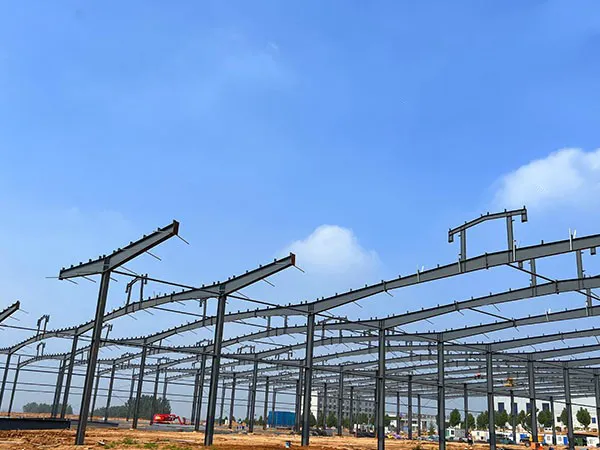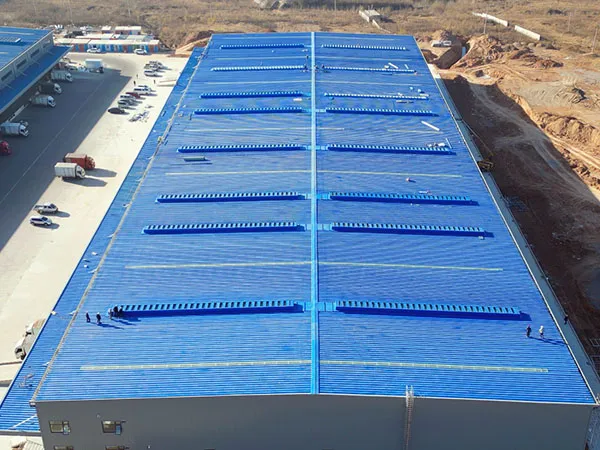Time:2025-01-23 13:08:54 Source:Sanjian Meichen Steel Structure
At its core, a steel structure is a framework made primarily of steel members that are connected to support loads and resist forces. These structures can range from small residential buildings to massive skyscrapers, bridges, and industrial complexes. The key is that the structural integrity and load-bearing capacity relies on the properties and arrangement of the steel components.Steel structures are widely used in construction due to their strength, durability, and flexibility.
Steel structures are widely used in various construction projects due to their high strength, lightweight, flexible construction, and short construction periods. Steel structures can be divided into various types based on different design and functional requirements, each with unique advantages in practical applications.

Portal frame structures are primarily used in single-story buildings such as warehouses, factories, and exhibition halls. Their characteristic feature is a portal-shaped frame formed by rigidly connecting columns and beams. This allows for long-span designs, reduces internal support, and maximizes space utilization.
Applications: Single-story factories, warehouses, exhibition halls
Features: Columns and beams are rigidly connected to form a portal frame. The long-span design reduces internal support and improves space utilization.
Advantages: Short construction period, low cost, and high structural stability.
A frame structure consists of beams and columns and is suitable for multi-story buildings, such as office buildings and commercial complexes. This structural form offers excellent seismic resistance and flexible spatial layout, adapting to different functional requirements.
Applications: Multi-story office buildings, commercial complexes
Features: Composed of beams and columns, flexible spatial layout
Advantages: Excellent seismic performance, adaptable to diverse functional requirements
Composed of triangular elements connected together, a truss structure is widely used in structures such as roofs, bridges, and large exhibition halls. Its advantages include light weight, large spans, and high material efficiency.
Applications: Bridges, large exhibition halls, factory roofs
Features: Triangular unit connections, light weight, and large spans
Advantages: High material efficiency, uniform structural load distribution
A space frame structure is a three-dimensional structure suitable for large buildings such as stadiums and airport terminals. It is characterized by its ability to cover large areas, excellent structural stability, and strong seismic resistance.
Applications: Stadiums, airport terminals, large exhibition halls
Features: Three-dimensional structure, can cover large areas
Advantages: Strong seismic resistance, high structural stability, and a modern visual effect
A lattice structure consists of intersecting steel rods and is commonly used in tall structures such as towers, transmission towers, and chimneys. Its advantages include high material efficiency, low structural weight, and its suitability for withstanding wind loads.
Applications: High towers, transmission towers, chimneys
Features: Composed of crossed steel rods, the structure is lightweight
Advantages: High material efficiency, can withstand wind loads and other dynamic loads
Plate girder structures are constructed from welded or riveted steel plates and are primarily used in bridges and large industrial buildings. They are characterized by their strong load-bearing capacity and are suitable for bearing heavy loads.
Applications: Bridges, large industrial plants
Features: Steel plates welded or riveted together to form beams
Advantages: Strong load-bearing capacity, suitable for heavy-load environments
Applications: High-rise buildings, bridges
Features: Circular or rectangular steel tube cross-sections
Advantages: Excellent bending and torsional resistance, overall structural stability
Composite structures combine steel with materials such as concrete to form steel-concrete composite structures. Commonly used in high-rise buildings and bridges, they leverage the advantages of both materials to improve structural performance.
Applications: High-rise buildings, bridges
Features: Combination of steel and concrete
Advantages: Leveraging the strengths of both materials to improve load-bearing capacity and durability
Special structures include arches, domes, and towers, and are suitable for special-purpose buildings such as stadiums, exhibition halls, and signal towers. Their design flexibility allows them to meet specific functional and aesthetic requirements.
Applications: Stadiums, exhibition halls, communication towers
Features: Arches, domes, pylons, and other forms
Advantages: Flexible design, combining functionality with aesthetics

Choosing the Appropriate Steel Structure Type: Considerations and Recommendations
When selecting a steel structure type, consider the following factors:
● Load Requirements: Select an appropriate structural form based on the type and magnitude of loads the building will withstand.
● Span Requirements: Truss or space frame structures are suitable for large-span buildings, such as stadiums and exhibition halls.
● Seismic Performance: Frame structures with good seismic performance should be prioritized in earthquake-prone areas.
● Aesthetic Requirements: Special structures, such as domes and towers, can meet unique aesthetic design requirements.
● Construction Conditions: Consider on-site construction conditions and construction timelines to select an appropriate structural form.
Steel structures, due to their excellent performance and diverse forms, have become an indispensable component of modern architecture. In practical applications, the appropriate choice of steel structure type can improve a building's safety, cost-effectiveness, and aesthetics. We hope this article will help you understand the types of steel structures.